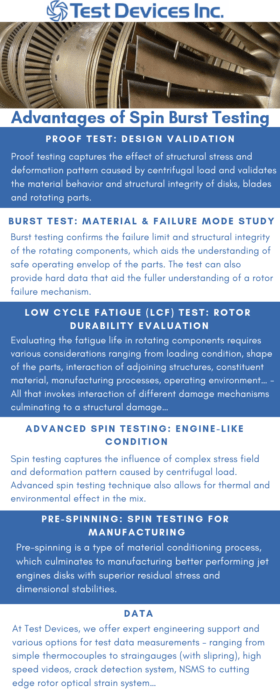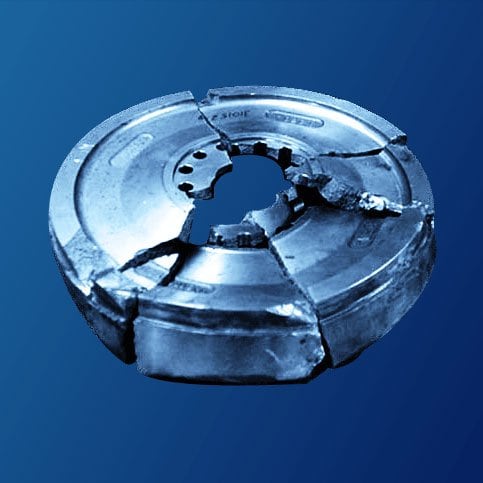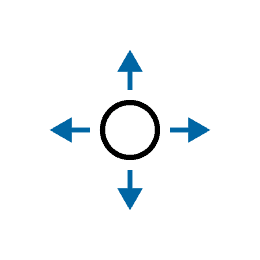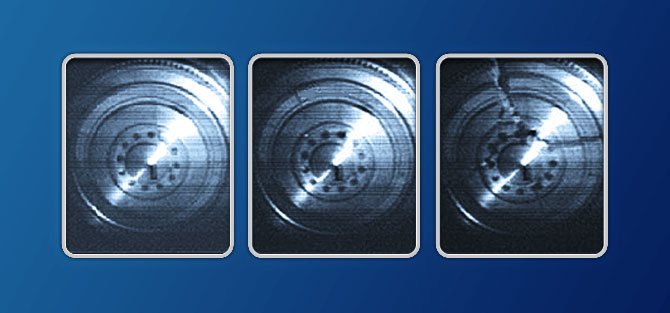Spin Burst Testing
The Issue
High-speed rotating machinery stores huge amounts of kinetic energy. When one or more rotating components burst, that energy is released. For example, a rotor weighing 272 kg (600 lbs), having a diameter of 76 cm (30 in) and spinning at 14,000 rpm has an energy equivalent of 2.1 x 107 Joules. This is equivalent to the power of some bombs. Even small rotors spinning at high speed can cause catastrophic damage during a burst. Because of the potential danger associated with rotating component failure, governing authorities such as the Federal Aviation Administration (FAA) often require spin burst testing in order to establish margins of safety above maximum rated operating speeds (burst margins) for critical rotating components.
Download Our Spin Testing Ebook
Why it Matters
If not contained, the fragments projected during a burst can penetrate a machine housing, aircraft fuselage, etc., causing catastrophic damage to equipment. More importantly, a burst can pose a significant and potentially fatal threat to anyone within the event sphere. Any product that does not protect the public in such cases exposes the manufacturer to litigation and added costs related to insurance and regulation. Aside from safety considerations and the value in determining effective containment designs, spin burst testing is also used to confirm the ultimate limits to which a rotating system can be operated.
Download Our Spin Testing Ebook
What You Can Do
Rotational testing to the point of burst offers manufacturers valuable information about the ultimate strength of a component part or material. Test Devices has expertise and experience in the specialized techniques of spin burst testing, strain measurement, failure analysis, and the design of burst containment measures. Our Spin Tests are capable of conducting spin burst testing to contain fragments that are projected or deflected in both rotational in-plane and out-of-plane projectiles directions. This is an important feature since the energy that is not absorbed by the spin rig walls will be deflected upwards towards the lid – a result that has been often documented in practice; sometimes with serious consequences. We have invested in top-flight equipment, instrumentation processes, data recording, and personnel to provide our customers with the critical information they require while safeguarding against property damage and personal injury.
Download Our Spin Testing Ebook
Advantages of Spin Burst Testing
 Design Validation: Spin burst testing provides hard data that rotating component design and performance is within safe operating limits. If the speed at which a rotor bursts is within a predicted failure range for a given temperature and/or temperature gradient, the resulting data validates design intent and subsequent engineering.
Design Validation: Spin burst testing provides hard data that rotating component design and performance is within safe operating limits. If the speed at which a rotor bursts is within a predicted failure range for a given temperature and/or temperature gradient, the resulting data validates design intent and subsequent engineering.
Materials Validation: While slight changes in materials and processing may seem inconsequential, without testing there is no way to know the impact of a substitute material or change in processing procedures. Spin burst testing validates the best choice of materials and processes to meet all safety considerations at the most economical cost.
Reduction of Manufacturing Costs: By evaluating failure modes using good data, equipment designers can optimize design of both rotating equipment and static containment systems. Periodic spin burst testing during production can also validate that materials are within specifications and manufacturing processes are being adhered to.
Failure Analysis: Spin burst testing a component provides customers with data regarding the component mode of failure that can be used to evaluate failure risk and to design appropriate containment. If Test Devices’ High-Speed Video is employed, additional clues as to the origin and mode of failure can be ascertained. Test Devices can also include a ring of material around the test component known as Soft Containment. This material captures burst fragments while preserving the condition of the fracture surfaces, enabling further analysis into the initiation and propagation of cracking.
Containment Evaluation: Failing a high-speed component provides an opportunity to test the capability of the real-world containment structure. Spin test chambers provide a safe environment to evaluate the capability of containment designs. Should the containment fail, the robust spin chamber is there to prevent component fragments from endangering other equipment or personnel.
Establish Safety Margin: A spin burst test establishes the speed at which a rotating component fails and allows customers to calculate the safety margin between the operational speed and the speed at which the component fails.
Some Applications for Spin Burst Testing
| Jet engine components | Gears | Compressor rotors |
| Turbine rotors | Centrifuge rotors | HVAC fans |
| Turbofans | Impellers | Metallic flywheels |
| High-speed fans | Turbochargers | Composite flywheels |
| High-speed machine tools | Electric motor rotors | Grinding wheels |















